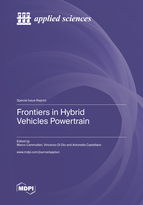Frontiers in Hybrid Vehicles Powertrain
A special issue of Applied Sciences (ISSN 2076-3417). This special issue belongs to the section "Mechanical Engineering".
Deadline for manuscript submissions: closed (7 January 2023) | Viewed by 20486
Special Issue Editors
Interests: hybrid vehicle powertrain; power-split transmission; CVT’s; planetary gearing; planar mechanisms; mechanical vibrations; energy management strategy
Special Issues, Collections and Topics in MDPI journals
Interests: modeling, design and control of power converters; power converters for renewable energy sources; mathematical models of electrical machines, drives, control and diagnostics
Special Issues, Collections and Topics in MDPI journals
Special Issue Information
Dear Colleagues,
The ongoing aggravation of the environmental issue requires us to urgently move toward alternative powertrains in ground vehicles. In this respect, hybrid electric vehicles (HEVs) emerge as the main sustainable solution to increasingly adopt in the very near future. Indeed, the synergy between the internal combustion engine and the electric unit enables a significant reduction of both fuel consumption and emissions, while maintaining high vehicle performance and driving comfort.
Nonetheless, a wide variety of hybrid electric powertrains is currently available on the market, ranging from several driveline architectures (series, parallel, and power-split hybrid) and degrees of electrification (mild, full, and plug-in hybrid). Moreover, the internal combustion engine can be supported for vehicle propulsion by other power sources rather than the electric unit—for example, by a hydraulic system. Furthermore, the transmission systems deployed to interface the different sources and propel the vehicle often differ from the traditional ones; thus, proper mathematical tools are needed.
This Special Issue aims to gather original contributions on hybrid vehicle powertrains, as well as exhaustive overviews on the state of the art, including recent advances in this field. In particular, researchers are encouraged to propose innovative hybrid technologies, enhancements of the energy storage system (i.e., battery in HEVs) and of the related battery management system, efficiency-oriented control strategies for electric machines, and novel mathematical models for comprehensively addressing hybrid powertrains. In this regard, studies on the optimization of multimode power-split transmissions will be particularly appreciated, being the most promising transmission system owing to its great versatility. Lastly, providing experimental results on hybrid vehicles emissions, fuel-saving, and performance would be a major contribution to our scientific community.
Prof. Dr. Marco Cammalleri
Prof. Dr. Vincenzo Di Dio
Dr. Antonella Castellano
Guest Editors
Manuscript Submission Information
Manuscripts should be submitted online at www.mdpi.com by registering and logging in to this website. Once you are registered, click here to go to the submission form. Manuscripts can be submitted until the deadline. All submissions that pass pre-check are peer-reviewed. Accepted papers will be published continuously in the journal (as soon as accepted) and will be listed together on the special issue website. Research articles, review articles as well as short communications are invited. For planned papers, a title and short abstract (about 100 words) can be sent to the Editorial Office for announcement on this website.
Submitted manuscripts should not have been published previously, nor be under consideration for publication elsewhere (except conference proceedings papers). All manuscripts are thoroughly refereed through a single-blind peer-review process. A guide for authors and other relevant information for submission of manuscripts is available on the Instructions for Authors page. Applied Sciences is an international peer-reviewed open access semimonthly journal published by MDPI.
Please visit the Instructions for Authors page before submitting a manuscript. The Article Processing Charge (APC) for publication in this open access journal is 2400 CHF (Swiss Francs). Submitted papers should be well formatted and use good English. Authors may use MDPI's English editing service prior to publication or during author revisions.
Keywords
- hybrid vehicle powertrain
- hybrid electric vehicle
- alternative propulsion system
- emissions reduction
- power-split hybrid
- multimode transmission








